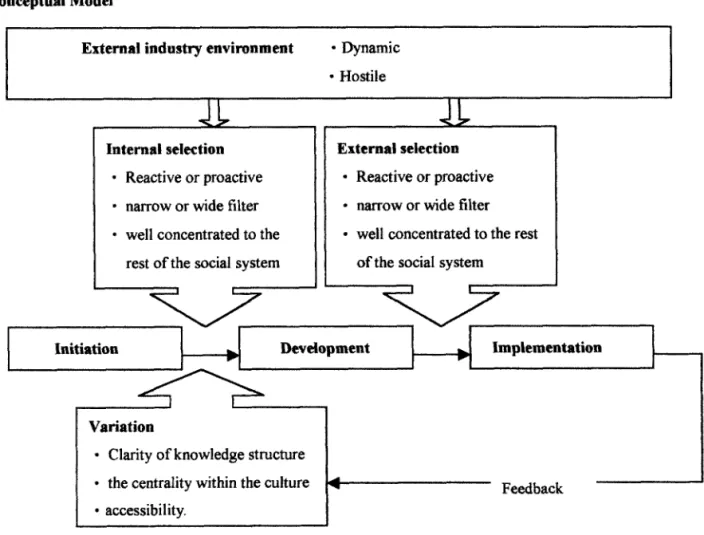ORGANIZATIONAL CREATIVE PROCESS FROM AN
EVOLUTIONARY PERSPECTIVE:
THE CREATIVE PROCESS OF TAIWANESE INTERNET FIRMS
Se-Hwa
Wu,Institute of Technology and Innovation Management, National Chengchi University,
Taipei 106, Taiwan
886-2-2939309 l # 8862 7, sehwa~ccu, edu. tw
vMei-ya Wang, Institute of Technology and lnnovation Management, National Chengchi University,
Taipei 106, Taiwan
8 8 6 - 2 - 9 3 9 3 0 9 1 # 8 1 1 4 4 ,
cel i~¢w@t~¢net, net
ABSTRACT
This paper uses a personal creativity theory to analogize organizational creative process and tries to build a model of organizational creative process. This approach analyses creativity from an evolutionary viewpoint, which believes creativity is the process of variation, selection and retention. In our model, organizational creative process begins from generation of variation, which must survive under the internal selection and external selection, thus becomes a
recognized creativity or innovation. By application of this model, we can explain what characteristics of industry and organization will generate better creativity. Additionally, industry environment will influence organizational creative process through internal selection and external selection criteria setting. This paper takes Talwanese internet industry for case study.
BACKGROUND
There have long been four different approach which includes product, personality, place and process, so-called "4P" in creativity theory. Some researchers propose that through improving cognitive skills or creativity-relevant skills (process perspective ) people can enhance their creative performance. In contrast, there have been few efforts in understanding organizational creative process and entrepreneurial process (Russell, 1999[l]; Brazeal & Herbert,
199912]).
From the process perspective, we can capture the dynamics of the creative process itself and know how creative ideas generated and survived under environmental pressure. Many researchers thinks that creativity or innovation is a process of evolution (Csiksentmihalyi, 199613]; Kwasnicki,, 1996[4]). Through variation, selection and retention, creativity becomes accepted as part of our culture. There are few efforts to use personal creativity theory into organizational-level creativity, especially in non-individual perspective. Therefore this paper uses a personal creativity theory, which addressesevolutionary process, to analogize organizational creative process, and build a model of organizational creative process.
RESEARCH OBJECTIVES
The objective of this paper is to build a model that describes an organizational creative process. By building the model,
this paper will try to answer the following questions:
1. From an evolutionary perspective, what process does an organizational pass through to generate creativity? 2. From an evolutionary perspective, what characteristic o f organization will have better creativity 9.
3. From an evolutionary perspective, what characteristic o f industry will have better creativity and innovation? 4. What influence does industry environment have on organizational creative process?
M E T H O D O L O G Y
This paper tries to build a model o f an organizational creative process. We first review creativity and intrepreneurship theory and then based on individual creative process to analogize organization creativity. By theory deduction, we build a conceptual model and develop tentative propositions.
Furthermore, we will observe the creative process o f Taiwanese internet firms to further test and modify the tentative
propositions. The cases are chosen with the level o f influence on the existing domain( Csiksentmihalyi, 1996). Seven
internet firms are observed, including two firms in technology domain and five firms in non-technology domain, such as electronic newspaper, internet radio, community and so on.
Conceptual Model
External industry environment
• Dynamic • HostileInternal selection
• Reactive or proactive • narrow or wide filter • well concentrated to the
rest o f the social system
I
Initiation
,I
I
Variation
• Clarity o f knowledge structure • the centrality within the culture • accessibility.
Figure 2. The conceptual model
External
selection • Reactive or proactive • narrow or wide filter • well concentrated to the resto f the social system
" - ' p - " '
'1
' ° " ' ° - " "
Feedback
TENTATIVE PROPOSITIONS
Proposition 1. The clarity of knowledge structure in an organization will affect the rate of creative ideas that the organization can generate.
Proposition 2. If innovation are highly valued in the culture, the organization will have better creativity.
Proposition 3. If knowledge in an organization is highly accessible to organizational members, the organization will have better creativity
Proposition 4, If organizational internal gatekeepers are proactive in searching innovation, the organizations will have better creativity.
Proposition 5. If organizational internal gatekeepers take wider filter in internal selection, the organizations will have better creativity
Proposition 5.1 If the cost of commercialization is lower, organizational internal gatekeepers will take wider filter. Proposition 6. If an organizations have a central position in its industry network, the organization will have better creativity
Proposition 7. If consumers (market gatekeepers) are proaetivein searching innovation, the industries will have better creativity
Proposition 8. If consumers (market gatekeepers) take wide filter in external selection, industries will have better creative performance.
Proposition 9. If consumers (market gatekeeper) have variety of preference, the industries will have better creative performance.
Proposition 10. If industries have better positions in social network, the industries will have better creativity Proposition 11. Industry environment will influence internal selection and external selection criteria setting.. Proposition 12. Internet industry environment is highly dynamic, therefore there are more active entrepreneurial activities in internet industry.
Proposition 13. The more hostile the latest stage ofinternet industry development is, the better creativity will show in this industry.
Proposition 14. Due to low commercialization cost and variety of consumers' preferences, internet industry have better creativity.
REFERENCE
[1] Russell R.D. "Developing a process model of intrapreneurial systems: A cognitive mapping approach", Entrepreneurship Theory and Practice, spring 1999.
[2] Brazeal, D.V. & Herbert, T.T. The genesis of entrepreneurship, Entrepreneurship Theory and Practice, spring 1999. [3] Csiksentmihalyi.M. Creativity, HarperCollins Publishers, New York, 1996.
[4] Kwasnicki, W. Knowledge, innovation and Economy: Evolutionary exploration, Edward Elgar Publishing Limited, 1996.
